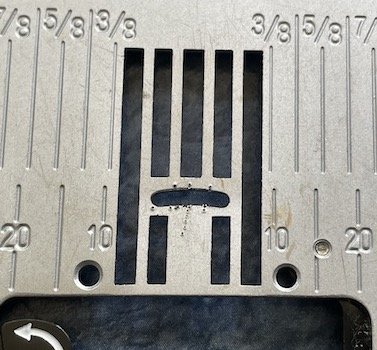Hello Creative Community!
Wednesday is Understanding Your Creative Partner Day!
As mentioned before, it is very difficult to be creative and to find joy in the process if your sewing machine is acting up! Join me every Wednesday, if you want to gain knowledge about your sewing machine!
Today we will discuss Why Needles Break!
On Monday, I left you with a picture of a very cruddy bobbin case with a broken needle point in it. Here are some more needle bits that I have fished out of machines!

Obvious reasons why your needle will break.
- You sewed over a pin and the needle struck the pin. Usually when this happens, a portion of the needle flies toward your face.
- Prevention: Don't sew over pins!
- Thread jams under the throat plate.
- Your machine will continue to try to form a stitch but the jam pulls the thread tight and pulls/twists the needle.
- This topic was discussed in the Newsletter on March 29. See the home page of the website, SNIPPETS, to access past newsletters or Click Here.
- You have cleaned your machine and your bobbin case is not positioned correctly
- This can cause you to stitch through the bobbin case causing the needle to break.

- You are sewing at too high of a speed for your fabric type or project thickness.
- Slow down and enjoy the process!
- I frequently see this when people embroider at full speed on a very dense design.
- Single opening stitch plate
- The opening in your throat plate is for center needle position only.
- Change to a larger opening in your throat plate
- You haven't changed the needle in a really long time and it is really very very dull.
- Prevention: Change your needle every 6-8 sewing hours.
Not so obvious reasons why your needle will break
- The needle strikes your throat plate.
- You can see the numerous holes around the opening in your throat plate as pictured below.
- I see this frequently when I am repairing machines.
- Take a minute to examine your throat plate.

- Why does this happen?
- People generally think this happens because the needle is not "heavy" enough. That is almost NEVER true!
- The strikes to your throat plate occur when you pull or push your fabric.
- Some of you have seen the "experts" sewing without pins and recommending you just pull your fabric from the front and back. DON'T! Your needle will deflect and strike the throat plate.
- Often you are pulling your fabric because your project is too thick.
- You will find this in machines that do not have a high presser foot lift.
- The only way to make the fabric move under your foot is to pull it.
- As you pull your fabric the needle bends and strikes the edge of the throat plate!
- Sometimes the fabric is pulled forward by your body or gets stuck between your body and your sewing table!
- Maybe your project is very large or heavy and is not supported by your sewing table once again pulling your needle.
There are many reasons why your needle will break but rarely is it an issue that needs to be "fixed" by your sewing machine repair person.
Reminder: Do try to find all of the pieces of the broken needle before restarting your stitching.
If you have any questions on the information covered above please contact me by calling the shop!
Knowledge can be Sew Empowering!
Cathy | 


